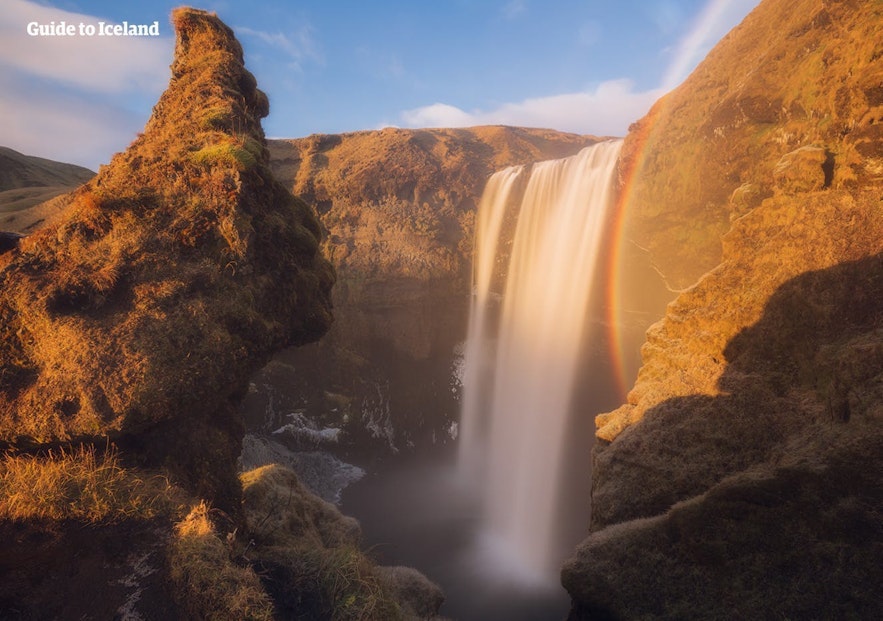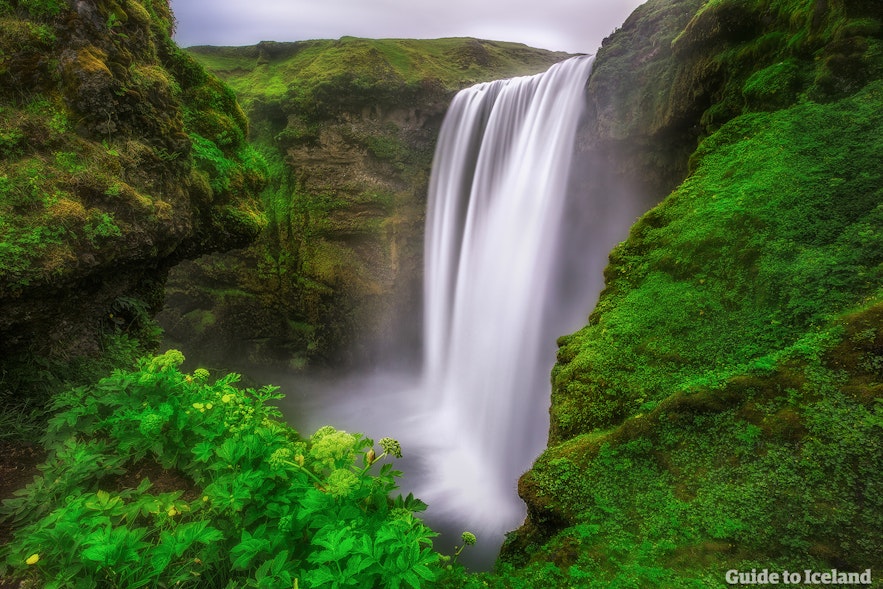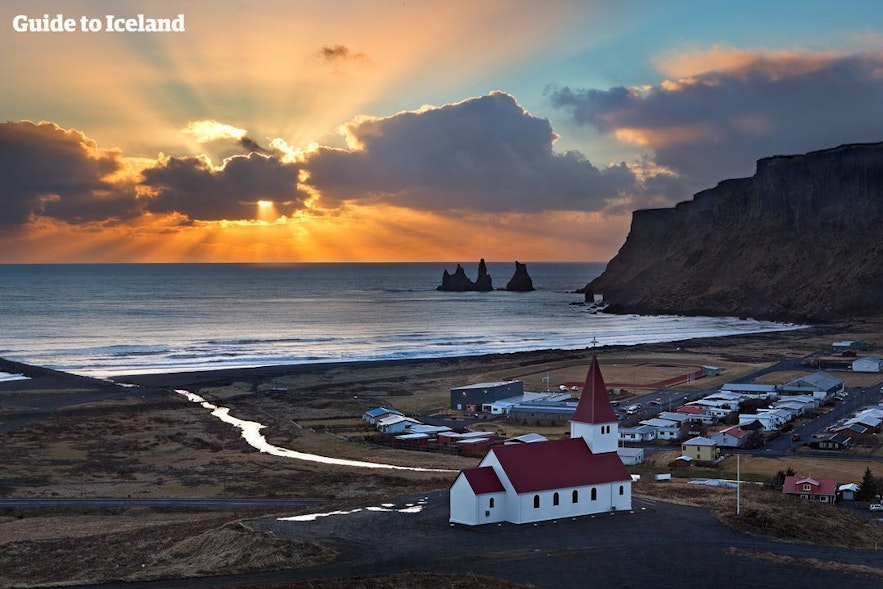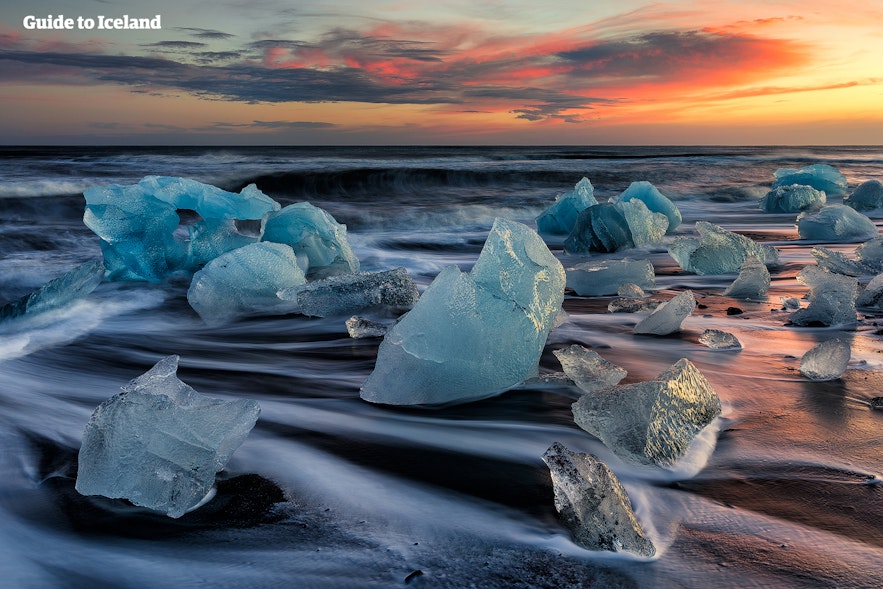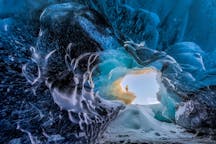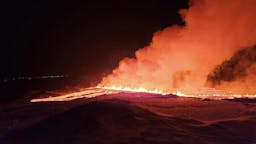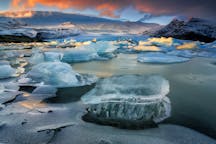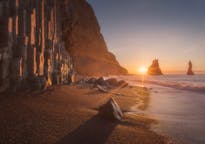
Highlights from Iceland's South Coast

Extending from the south of Reykjavik to the famous Jökulsárlón glacier on the Vatnajökull National Park, Iceland's South Coast gathers many wonders for nature lovers.
Waterfalls, glaciers, kilometers upon kilometers of an otherworldly landscape and breath-taking black sand beaches can all be found in this region. Here are my favourite jaw-dropping attractions on the south coast:
Seljalandsfoss Waterfall
Seljalandsfoss is one of Iceland’s most famous waterfalls, and thanks to its curvature and distance from the cliffs travellers that visit the south coast during summer can even walk behind it. The impressive 63 meters drop can be seen from the ring road and creates enough drizzle to leave you soaking wet, so make sure to wear waterproof clothing.
The path is closed during winter as it gets too slippery, but visiting Seljalandsfoss is a must even if it’s snowing. The contrast between the frozen river and the dancing waterfall is mesmerizing and you will definitely spend a long time taking photos there. Nearby Seljalandsfoss there is also the secret Gljúfrabúi waterfall, hidden inside a slit on the cliff away from tourists.
Skógafoss Waterfall
30 kilometers away from Seljalandsfoss is Skógafoss, a 60m high and 25m wide waterfall where you can definitely feel the force of nature. According to the legend, behind Skógafoss there is a huge chest full of treasures that was hidden by the first Viking who lived in the region.
It’s possible to get close to the waterfall even in winter and there’s also a path leading up to the top, but if climbing 500+ steps seems too daunting don’t worry - the most impressive view is still from the bottom of the waterfall.
Sólheimajökull Glacier
Picture from Solheimajokull Ice Climbing & Glacier Hike
A part of Mýrdalsjökull, one of the biggest glaciers in Iceland, the history of Iceland is engraved on the stunning Sólheimajökull glacier. Frozen streams that can be seen through the clear ice, rocks and marks from past eruptions that over thousands of years have slowly changed the country’s landscape… More recently the glacier has been telling a sad story though, as the ice melts rapidly due to climate change – it’s calculated that if nothing changes, the glacier will be completely gone within a century.
You can also go for a glacier hike on Sólheimajökull, however do not step on the ice unless an experienced guide accompanies you. Visiting a glacier by yourself is extremely dangerous, as you won’t know which parts of the ice are safe to step on and any changes in temperature might make some spots inaccessible.
Vík í Mýrdal
Approximately 180km from Reykjavik, Vík is the southernmost village in Iceland and while less than 300 people live there it’s still the biggest in the region. The main attraction inside the village is the Icelandic-style Reyniskirkja white church, which looks extremely photogenic against the wild background. But the real highlights from Vík í Mýrdal are all around the village: waterfalls, beaches, fields and mountains!
Vík’s Black Sand Beach is one of the most beautiful places I’ve ever seen in my travels, even though it’s completely different from the quintessential beach landscape. All the elements are there: sand, some cliffs, the sea and the waves, but it looks like you are on another planet or seeing the world through a black and white filter.
Reynisfjara Black Sand Beach
Named by National Geographic as one of the 21 best beaches in the world, the black tiny pebble Reynisfjara beach is famous for its wild Atlantic waves, basalt pillars and dark caves. And as if the stunning scenery and the Reynisdrangar rock formations are not enough, during summer it’s also possible to spot puffins around there!
Tourists must be careful when visiting Reynisfjara because of its violent waves, as the so-called “sneaker waves” can show up even when the beach seems quiet. This famous attraction now displays several warning signs and visitors are advised never to turn their back to the sea, always maintain a safe distance from the water and most of all, listen to commands from the guides in the area.
Seljalandsfoss, Skógafoss, the Sólheimajökull glacier and the black sand beaches can be seen on a day tour from Reykjavik even during winter, when there are not many daylight hours. However, to include more attractions on the darker months it’s recommended to opt for a two-day tour or staying for a couple of nights in the area (the cottages by the Reynisfjara beach would be a great option).
Jökulsárlón Glacier Lagoon
One of Iceland’s most famous tourist attractions! In this massive glacier lagoon you can see big blocks of ice floating around as they make their way out to the open sea.
During summer there are boat tours that bring you even closer to the icebergs (however don’t attempt to walk on the ice as it’s extremely dangerous!), and during winter you can book a glacier hike and explore the ice caves in Vatnajökull.
Make sure to also visit the Diamond Beach, a stretch of black sand dotted with glistening ice crystals in various shapes and sizes.
- Find Jökulsárlón Tours here.
기타 흥미로운 블로그

아이슬란드 공항으로의 첫 발
아이슬란드라는 낯선 나라에 도착하여 가장 먼저 마주하는 것이 공항이죠. 여행의 시작인 공항입국을 무사히 잘 할 수 있도록, 도움이 될만한 정보들을 제 경험을 통해 짚어보실 수 있습니다! 내가 도착하는 아이슬란드의 공항은? 도착하면 어디로 가야 할까요? 아이슬란드어와 영어만이 존재하는 이 낮선 곳에서 어떻게 여행을 시작할까요? 도착 공항 케플라비크 공항?더 읽기
스나이펠스네스 반도 당일 투어 후기 - 아이슬란드의 아름다운 서부!
아이슬란드를 여행하면서 가장 많은 사람이 방문하는 곳은 남부해안인데요. 그 보다 가까운 거리이지만 아주 멋진 서부지역, 아이슬란드의 축소판이라 불리는 스나이펠스네스 반도를 다녀왔어요! 정말 멋진 여행이었습니다! 먼저 스나이펠스네스 반도는 아이슬란드의 어디쯤에 위치해 있는지 지도로 살펴볼까요? 스나이펠스네스 지도상의 위치 레이캬비크가 아이슬란드의 남더 읽기
아이슬란드 빙하를 탐험하다! - 솔헤이마요쿨 빙하하이킹
오늘은 솔헤이마요쿨 빙하에서 빙하하이킹 투어를 하는 날이에요. 드뎌 빙하 위를 걸을 수 있다는 설렘으로 아침을 시작했어요! 솔헤이마요쿨은 레이캬비크에서 약 두 시간 좀 넘는 거리에 있는 빙하로, 미르달스요쿨 빙하의 일부입니다. 1번 국도에서 지나가다 보면 보이는 빙하설 (빙하가 혀를 내밀고 있는 것처럼 지상으로 주욱 내려와 있는 모양)이기도 한데요.더 읽기

아이슬란드 최대의 여행 마켓플레이스를 휴대폰에 다운로드하여 전체 여행을 한 곳에서 관리하세요
휴대폰 카메라로 이 QR 코드를 스캔하고 나타나는 링크를 누르면 아이슬란드 최대 여행 시장이 내 손 안에! 다운로드 링크가 포함된 SMS나 이메일을 받으려면 전화번호나 이메일 주소를 추가하세요

